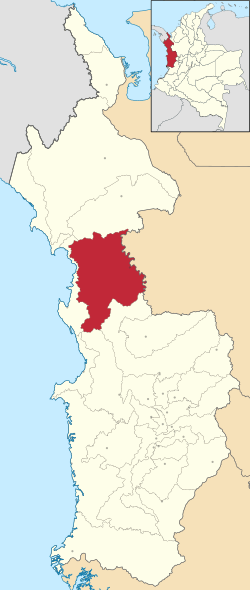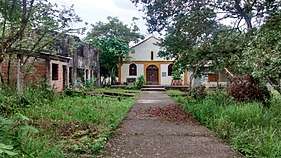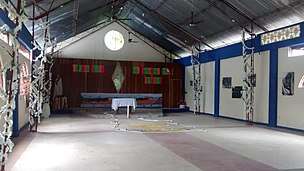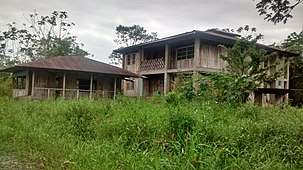Bojayá
Bojayá (Spanish pronunciation: [boxaˈmʝa]) is a municipality in the Chocó Department, Colombia, its municipal centre is the town Bellavista Nuevo. The Bojayá massacre occurred in the original Bellavista on May 2, 2002.
Bojayá | |
|---|---|
Municipality and town | |
.svg.png) Flag  Seal | |
| Motto(s): "Creatividad, Trabajo y Decisión" | |
 Location of the municipality and town of Bojayá in the Chocó Department of Colombia | |
| Coordinates: 6°31′25″N 76°58′28″W | |
| Country | |
| Department | Chocó Department |
| Area | |
| • Municipality and town | 3,693 km2 (1,426 sq mi) |
| Population (2005) | |
| • Municipality and town | 9,941 |
| • Urban | 4,572 |
| Estimation by DANE - Government of Colombia [1] | |
| Time zone | UTC-5 (Colombia Standard Time) |
An essentially new town was constructed, on a hill to avoid flooding, one kilometer upriver from the original Bellavista in 2003, and inaugurated in 2007. Whereby the original Bellavista was renamed to Bellavista Viejo (Old Bellavista in Spanish), and the new town Bellavista Nuevo (New Bellavista). [2] Bellavista Viejo is currently completely abandoned.
Bojaya municipality
The Bojaya municipality, according to a 2005 census, has 9941 inhabitants. 58.4% of the population of the municipality is afro-colombian, and 41.4% and indigenous Embera. 95.86% of the population do not have their basic needs met[3].
The municipality contains part of the Utría National Natural Park.[4]
There is still paramilitary and presence of the ELN in the region, tensions and violence between the groups are still threatening the population in the region.[5]
Bellavista Nuevo
Half of the inhabitants of the Bojayá region live in the municipal centre, Bellavista.[3] After the massacre, only a part of the population remained or returned to the region. The remains of the victims of the massacre are buried in the new town, a mausoleum has also been build in their memory.
Relocation
The new town one kilometer south of the original position. was built after the Bojayá massacre by the Colombian government. The relocation of Bellavista was announced on May 7, 2002, 5 days after the massacre by president Andrés Pastrana who visited the region after the massacre. The main reason for the relocation, namely the frequent flooding of the town, is a reality not exclusive to Bellavista, but rather common to the region. The majority of the town was in favour of a relocation, but the town was torn on the issue. The university Universidad Javeriana in Bogotá was put in charge of the design of the new town. The 265 houses were build of concrete, exceptional in the region, and provided with, among other services, a water installation and electricity.
Bellavista Viejo
The old town, Bellavista Viejo, is currently completely abandoned. The old San Pablo Apóstol church has been restored after the massacre in 2002, and is being maintained in memory of the tragic event. Every year, on the second of May, a memorial is held in the church. During this service, the statue of Christ mutilated in the massacre, el Christo Mutilado de Bojaya, is brought in a procession by river, from the new church in Bellavista Nuevo to Bellavista Viejo.[6]
Climate
Bellavista Nuevo, the capital of Bojayá has a very wet tropical rainforest climate (Af).
| Climate data for Bellavista Nuevo | |||||||||||||
|---|---|---|---|---|---|---|---|---|---|---|---|---|---|
| Month | Jan | Feb | Mar | Apr | May | Jun | Jul | Aug | Sep | Oct | Nov | Dec | Year |
| Average high °C (°F) | 31.5 (88.7) |
31.5 (88.7) |
31.9 (89.4) |
31.8 (89.2) |
30.8 (87.4) |
30.9 (87.6) |
31.0 (87.8) |
30.9 (87.6) |
30.2 (86.4) |
29.9 (85.8) |
30.1 (86.2) |
30.8 (87.4) |
30.9 (87.7) |
| Daily mean °C (°F) | 27.3 (81.1) |
27.3 (81.1) |
27.7 (81.9) |
27.8 (82.0) |
27.2 (81.0) |
27.3 (81.1) |
27.3 (81.1) |
27.2 (81.0) |
26.8 (80.2) |
26.5 (79.7) |
26.5 (79.7) |
27.2 (81.0) |
27.2 (80.9) |
| Average low °C (°F) | 23.1 (73.6) |
23.2 (73.8) |
23.6 (74.5) |
23.8 (74.8) |
23.7 (74.7) |
23.7 (74.7) |
23.6 (74.5) |
23.6 (74.5) |
23.5 (74.3) |
23.2 (73.8) |
23.0 (73.4) |
23.6 (74.5) |
23.5 (74.3) |
| Average rainfall mm (inches) | 362.8 (14.28) |
288.9 (11.37) |
284.2 (11.19) |
460.1 (18.11) |
482.3 (18.99) |
409.4 (16.12) |
512.3 (20.17) |
495.1 (19.49) |
398.7 (15.70) |
421.4 (16.59) |
481.5 (18.96) |
470.3 (18.52) |
5,067 (199.49) |
| Average rainy days | 17 | 14 | 15 | 21 | 23 | 23 | 23 | 24 | 23 | 24 | 23 | 23 | 253 |
| Source: [7] | |||||||||||||
References
- https://www.dane.gov.co/files/investigaciones/poblacion/proyepobla06_20/Municipal_area_1985-2020.xls
- Bojayá: La Guerra Sin Límites. Bogotá, Colombia: Aguilar. 2010. p. 192. ISBN 978-958-758-024-2.
- Vergara-Figueroa, Aurora (2018), "They Kill Us, Therefore We Exist?", Afrodescendant Resistance to Deracination in Colombia, Springer International Publishing, pp. 53–68, doi:10.1007/978-3-319-59761-4_3, ISBN 978-3-319-59760-7, retrieved 2020-05-13
- Utría (in Spanish), colparques.net, retrieved 2017-06-21
- Fernández, Richard Aguirre (2020-01-03). "En Bojayá vuelven a sentir temor por grupos ilegales". www.elcolombiano.com (in Spanish). Retrieved 2020-05-13.
- Tiempo, Casa Editorial El (2017-11-22). "De la devastación a la esperanza: así se levanta Bojayá". El Tiempo (in Spanish). Retrieved 2020-05-13.
- "Data". www.ideam.gov.co. Archived from the original on 2016-08-15. Retrieved 2020-06-26.
External links
 Bellavista Viejo, abandoned, on the left: part of the old school; centre: The restored church.
Bellavista Viejo, abandoned, on the left: part of the old school; centre: The restored church. The current interior of the Bellavista Viejo church, where the Bojayá Massacre took place in 2002.(in Spanish) Revista Semana: Un Pueblo a la Espera
The current interior of the Bellavista Viejo church, where the Bojayá Massacre took place in 2002.(in Spanish) Revista Semana: Un Pueblo a la Espera Casa de las Hermanas Agustinas, here about 100 inhabitants took refuge during the massacre in 2002.
Casa de las Hermanas Agustinas, here about 100 inhabitants took refuge during the massacre in 2002.